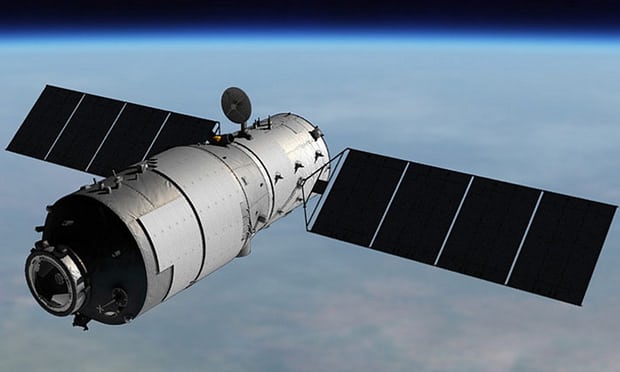The Chinese space agency lost control of its Tiangong-1, or Heavenly Palace, spacecraft in 2016, five years after it blasted into orbit to make China only the third nation to operate a space station after the US and Russia.
The defunct module is now at an altitude of 150 miles and being tracked by space agencies around the world, with the European Space Agency’s centre in Darmstadt predicting a fiery descent for it between 27 March and 8 April.
Hurtling around the Earth at about 18,000mph, the module ranks as one of the larger objects to re-enter the atmosphere without being steered towards the ocean, as is standard for big and broken spacecraft, and cargo vessels that are jettisoned from the International Space Station (ISS), to reduce the risk to life below.
The spacecraft’s orbit ranges from 43° north to 43° south, which rules out a descent over the UK but includes vast stretches of North and South America, China, the Middle East, Africa, Australia, parts of Europe – and great swaths of the Pacific and Atlantic oceans.
Western analysts cannot be sure how much of the spacecraft will survive re-entry, because China has not released details of the design and materials used to make Tiangong-1. But the spacecraft may have well-protected titanium fuel tanks containing toxic hydrazine that could pose a danger if they land in populated areas.
“To make any sensible statement about what will survive, we’d need to know what’s inside,” said Stijn Lemmens, a space debris analyst at the ESA’s Darmstadt centre. “But the only ones who know what’s onboard Tiangong-1, or even what it’s made of, are the Chinese space agency.”
As a prototype space station, Tiangong-1 is far smaller than the ISS. Constructed over decades, the ISS is the size of a football field and has the living space of a five-bedroom house. It weighs more than 400 tonnes. Tiangong-1, by comparison, weighs about 8.5 tonnes and is a mere 10 metres long and 3 metres wide. While it has two sleeping berths, the eating area and toilet appear to be aboard the Shenzhou module that docks with the station when Chinese spacefarers arrive.
“When people hear ‘space station’ they tend to think of the International Space Station or the Mir space station, but this is a lot smaller than those,” Lemmens said. “What we can say from size and shape and mass is that it’s in the same category as the cargo vehicles used to provide services to ISS, such as the Progress modules and the European ATV.” In 2015, a 7.5-tonne Russian Progress vessel that broke down en route to the ISS fell back to Earth and burned up over the Pacific, with only a few small pieces thought to have survived.
Though bijou by space station standards, Tiangong-1 hosted several taikonauts, including China’s first female astronaut, Liu Yang, in 2012. The interior of the spacecraft has white panelled walls and a dark floor to help visiting spacefarers build up a sense of up and down and so feel less disoriented.
Many space agencies perform a risk assessment before spacecraft are launched, in case of malfunctions in orbit. If the chances of someone being injured by debris that survives re-entry are greater than one in 10,000, a “controlled re-entry” is used to steer the spacecraft into a patch of the South Pacific known as the “spacecraft graveyard”. It is not known whether the Chinese space agency performed such a risk assessment.
Presented with the uncontrolled re-entry of Tiangong-1, 13 space agencies are using the event to test new tracking models and equipment, including radar, lasers and optical telescopes. Over the coming days and weeks, the agencies will pool their data in a bid to sharpen their predictions of where and when the object will fall.
The vagaries of re-entry mean it is impossible to say with much accuracy where Tiangong-1 will hit until its final moments. Only in the final hours will analysts be able to exclude the vast majority of the planet’s surface, but this will leave long, thin tracks that can circle the Earth. “Along one of these tracks, the breakup itself can spread fragments over thousands of kilometres,” Lemmens said. The tracks are narrow, however, reaching tens of kilometres wide at most.
With so much of Earth’s surface covered in water, the chances are high that Tiangong-1 will re-enter over an ocean, and it may not even be seen. And while pieces of space debris fall to Earth every day, only one person is known to have been hit by space junk, and she was not injured.
Richard Crowther, chief engineer at the UK Space Agency, said: “Given Tiangong-1 has a larger mass and is more robust, as it is pressurised, than many other space objects that return uncontrolled to Earth from space, it is the subject of a number of radar tracking campaigns. The majority of the module can be expected to burn up during re-entry heating, with the greatest probability being that any surviving fragments will fall into the sea.”
The Guardian
More about: space
















































